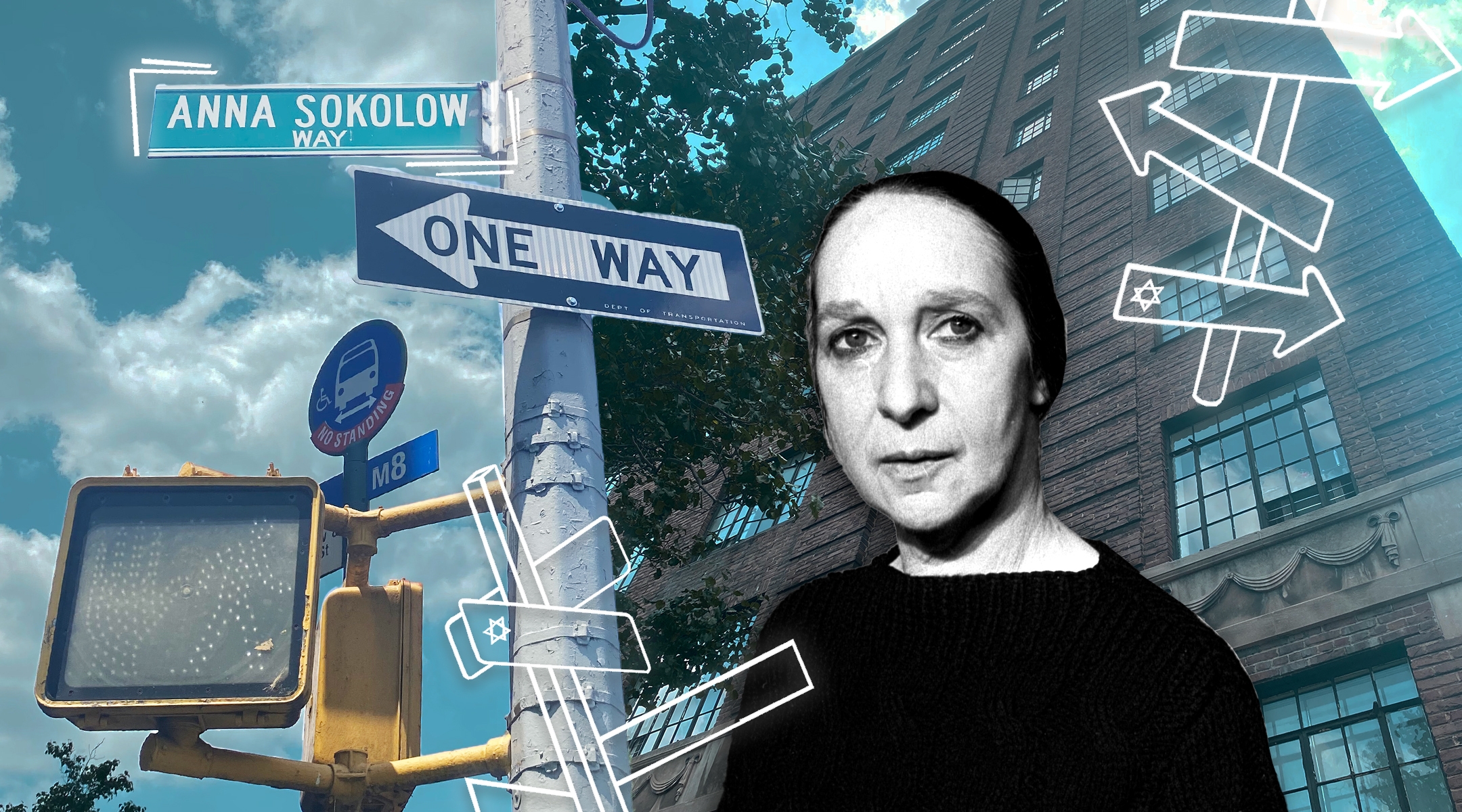Editor’s note: This article is part of a new series, Sign Post, which explores street signs and other locations around the city that are named in honor of Jewish New Yorkers.
(New York Jewish Week) — For more than 50 years, Jewish dancer and choreographer Anna Sokolow would sit at the window of her apartment at 1 Christopher Street, drawing inspiration from the colorful parade of people walking by.
A pioneer of modern dance, Sokolow was known for exploring the pressing issues of her lifetime, including the Great Depression, the Holocaust, the anti-Vietnam War movement and the American counterculture of the 1960s. Her aim, according to Jewish Virtual Library, was to challenge her audiences to think deeply about the world around them,
On March 31, 2004 — four years after her death at age 90 — the Christopher Street block where she lived, between Greenwich Avenue and Sixth Avenue, received the name “Anna Sokolow Way.” Linda Diamond, a dancer, neighborhood fixture and a friend of Sokolow, led the effort to name the street. As part of the dedication ceremony, Diamond and her dance company performed several of Sokolow’s works at the Lucille Lortel Theater down the street, the New York Times reported that day.
Sokolow, whose most famous works include “Lyric Suite” (1953) and “Rooms” (1955), gained renown for creating work that commented on society. And yet, “She was very clear about not being political, but that she made dances about what she saw,” Samantha Geracht, the artistic director of the Sokolow Theatre/Dance Ensemble, told the New York Jewish Week. “So she would consider it humanity.”
Sitting at Greenwich Village’s Rosecrans Florist and Cafe, located just below Sokolow’s apartment, Geracht — who joined Sokolow’s dance company, then known as Players Project and later renamed Sokolow Theatre/Dance Ensemble — reflected on her mentor’s life and legacy. “Like Jewish tradition, modern dance — and particularly the way Sokolow coached modern dance — is an oral tradition,” said Geracht, emphasizing that Sokolow’s works must be passed down person-to-person.
Anna Sokolow was born in 1910 in Hartford, Connecticut to Russian Jewish immigrants, but soon after, her family moved to the Lower East Side, where she grew up. She first stepped into dancing shoes at Emmanuel Sisterhood of Personal Service, a Jewish social welfare organization run by women, and later, the Henry Street Settlement House, where she trained under modern dance legend Martha Graham, among others.
In the 1930s, Sokolow became affiliated with the “radical dance” movement, which helped establish choreography as a way to shed light on society’s problems. Her first big choreographed dance, “Anti-War Trilogy,” was performed at the 1933 First Anti-War Congress, and, according to Jewish Virtual Library, in the mid-1930s, Sokolow became the youngest American choreographer to lead her own professional dance group. The first showcase of her work took place at the Young Men’s Hebrew Association in 1936.
Eventually, Sokolow went on to choreograph Broadway shows, including 1955’s “Red Roses for Me,” for which she was nominated for a Tony award. She also staged work for the New York City Opera.
Sokolow also incorporated her Jewish identity into her work: In 1945, as the horrors of the Holocaust came to light, Sokolow choreographed her artistic response, “Kaddish,” in which she wrapped herself in tefillin and depicted scenes of mourning. “Dreams,” which premiered in 1961, was another dance exploration of the Holocaust.
In the 1950s, Sokolow was invited to travel to Israel to work with the Yemenite dance company Inbal Dance Theater, and continued her visits until the 1980s.
“Sokolow belongs to American Jewish culture, and people don’t know, and they should,” Geracht said.
To that end, Geracht and the Sokolow Theatre/Dance Ensemble have worked to incorporate Sokolow’s dances into synagogue programming and have even written a curriculum for religious school students to learn about Sokolow and her legacy. They also teach at various colleges, often partnering with Hillel and dance organizations.
As a choreographer, Sokolow knew exactly what she wanted from her dancers, and got just that. But at the same time, she was generous to her company. “She would personalize [her choreography] to the point of each person feeling complete ownership of what they were doing,” Geracht said. “I think that was a gift to the dancer and a gift to the audiences.”
Geracht reflected how Sokolow could often be heard saying: “It’s not that I don’t love you, it’s that I love dance more.”
Upon her death in 2000, the Jewish Telegraphic Agency wrote that Sokolow was known for embracing “pessimistic themes” in her work. “I’m not neurotic,” a JTA News Bulletin quoted Sokolow as saying. “But I don’t have that happy philosophy, because what the hell is there to be happy about?”
Her stubbornness when it came to dance translated to other parts of her life as well. Geracht says she can’t recall a time — even when the choreographer was well into her 80s — when Sokolow would take the elevator. Sokolow was notorious for refusing to take a cab or the subway. Walking was another way for Sokolow to people watch, and everyone talked to her.
“Every storekeeper knew her. The homeless people knew her. They all knew who she was,” Geracht said. “And so she was a fixture of the neighborhood by nature of her personality and by nature of being a people-watcher.”
“She was a force to be reckoned with,” she added.
To find out about upcoming performances and learn more about Anna Sokolow’s dance legacy, visit SokolowTheatreDance.org
The New York Jewish Week brings you the stories behind the headlines, keeping you connected to Jewish life in New York. Help sustain the reporting you trust by donating today.





